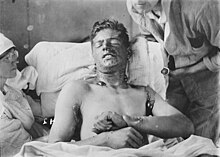
Back حرق كيميائي Arabic Kimyəvi yanıqlar AZ Poleptání Czech Verätzung German Quemadura química Spanish سوختگی شیمیایی FA Brûlure chimique French रासायनिक चोटें HI Causticazione Italian 화학화상 Korean
| Chemical burn | |
|---|---|
| Other names | Acid burn |
 | |
| Chemical burns caused by exposure to mustard gas during the First World War | |
| Specialty | Emergency medicine |
| Symptoms | itching, bleaching or darkening of skin, burning sensations, trouble breathing, coughing blood and/or tissue necrosis |
| Complications | Depends on the severity |
| Causes | most common include: sulfuric acid, hydrochloric acid, sodium hydroxide, lime, silver nitrate, and greater than 5% hydrogen peroxide solutions. |
| Treatment | Depends on the chemicals being exposed |
A chemical burn occurs when living tissue is exposed to a corrosive substance (such as a strong acid, base or oxidizer) or a cytotoxic agent (such as mustard gas, lewisite or arsine). Chemical burns follow standard burn classification and may cause extensive tissue damage. The main types of irritant and/or corrosive products are: acids, bases, oxidizers / reducing agents, solvents, and alkylants. Additionally, chemical burns can be caused by biological toxins (such as anthrax toxin) and by some types of cytotoxic chemical weapons, e.g., vesicants such as mustard gas and Lewisite, or urticants such as phosgene oxime.
Chemical burns may:
- need no source of heat
- occur immediately on contact
- not be immediately evident or noticeable
- be extremely painful
- diffuse into tissue and damage cellular structures under skin without immediately apparent damage to skin surface
Exposure to a toxic substance that is insufficient to cause a chemical burn can still be very serious, and the lack of a noticeable effect from a chemical exposure is not an indication of safety, particularly in the case of chronic exposure.